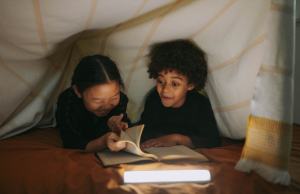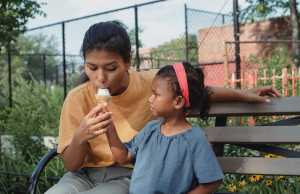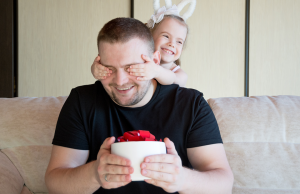
- Different stages of development are associated with common childhood fears and child anxieties, like fear of darkness, fear of strangers, or separation anxiety.
- Kids might feel afraid of dogs or bees, social situations, natural disasters, gun violence, and more.
- You can help children with rational and irrational fears by validating their feelings, gradually reintroducing them to the threatening stimuli, and modeling emotional regulation.
- We can also reassure children that though some dangers are out of our control, we will do everything we can to keep them safe.
When a child is scared, it’s natural for a parent to feel helpless. Childhood fears and specific phobias aren’t always rational, so you can’t just reason them away by saying, for example, “Only seven Americans die from spider bites every year,” or “Sweetie, there are zero monsters under your bed.” And it’s almost worse when a child’s fears seem perfectly valid, because that means that you, the parent, are probably scared as well. If your 10-year-old tells you that they don’t want to go to school or the grocery store because they’re afraid of a mass shooting, how are you supposed to reassure them? Chances are these same worries have kept you up at night as well.
So how can you help your child manage their fears so they aren’t debilitating? After all, research shows that developing brains suffer when they’re routinely flooded with stress hormones. Persistent fear responses in childhood can lead to lifelong cognitive issues. Children who are exposed to violence and trauma often need therapeutic intervention to undo that harm.
But with typical fears, loving caregivers can feel empowered to teach children how to regulate their occasional sense of overwhelm. Informed responses can help prevent kids from developing long-term anxiety, when their fear-system is chronically activated. Do we want our kids to fear the world, or to feel a sense of mastery and control? Well, many of us would like to wrap our children in soft blankets, equip them with dozens of teddy bears, and only release their vulnerable bodies into the wild within armored vehicles, but that’s no way to live. And besides, that treatment will only reinforce their fears.
This article offers evidence-based ways to talk to kids about what scares them so they can regain confidence in their environment, and in themselves. But keep in mind that any guide for talking to children about their fears also needs to take parental fears into account. It’s true that children instinctively pay more attention to ancestral threats like snakes and spiders, strangers and the dark, but they still rely on contextual information to determine whether they should feel scared. Caregivers are always providing this input, whether they’re aware of it or not.
Here are some ways to help a scared child feel safer, not defenseless.

Steps to Calm and Embolden a Scared Kid
A bee lands near your son where he’s playing in the grass and he breaks out in panicked screams. How do you handle it?
Let’s start with what you don’t do.
You don’t mock your child for their distress. You don’t ignore them. You don’t dismiss their feelings. You don’t isolate or punish them for being scared. These responses can make a child feel that it’s wrong to feel afraid. You want them to feel comfortable bringing their emotions to you, whatever they are.
When your child is having an epic freakout (not the clinical terminology), here’s what the experts say you should do:
- Help calm their acute distress. This usually involves physical touch. You hold your child’s hand, you rub their back, you help neutralize their body’s alarm system. There’s a difference between calming your child, however, and scooping them up to save the day, as if only you can ultimately provide them with safety. You don’t want to overreact or over-comfort. Essentially, the idea is to help children without helping too much. This teaches them emotional self-regulation. Guide your child to regulate their breathing by placing their hands on their belly so they can feel their deep breaths in and out. You are right there with them as they work to regain control.
- Validate their emotion. This can be as simple as saying, “I know that was really scary for you.” Children also tend to feel soothed when they can name or label an emotion.
- Move quickly onto something else. Instead of lingering in the comfort phase, distract your child. Bring up a subject that has nothing whatsoever to do with bees. Sing a song. Start a tickle fight. Help their threatened brains get back online.
- Help them talk about their fear. Later, when your child is calm and there’s an opportunity to discuss what happened, ask them specific questions about what scared them. You might be surprised by the content of their fear. For example, maybe your child was not afraid of being stung by the bee, but of the bee flying into his nose and building a hive in his stomach. You want to understand exactly what your child is afraid of so you can give them the information they need to feel safer.
- Use the stepladder approach. When children avoid what they’re afraid of altogether, they never get an opportunity to learn resilience and self-regulation. Avoidance might work as a short-term strategy, but in the long-term it could increase your child’s fear by reinforcing the idea that the world is a dangerous place. Here is where parents can really help. Together with your child, you can make a plan for gradual exposure or reintroduction to the threat. The steps on the stepladder can be as small as they need to be. For example, if your child is petrified of bees, they may only be comfortable reading a book about a bee. Then they might watch a movie about a bee. Then they might stand with you near a butterfly bush. The goals must be reasonable and have your child’s buy-in. This process might take a long time and go through a lot of iterations, so it’s important to be patient with your child. Reward them along the way with cuddles and high-fives. Remind them of times when they’re brave and strong.
- Help them revise their narrative. If a particular event triggered the fear or phobia, help your child retell their story. For example, if your child is scared of dogs because a puppy once nipped them, encourage them to include specific details when they recount the harrowing tale. Could the puppy have nipped them because they scared it with a loud noise? These narrative revisions can help your child understand that they don’t have to overgeneralize after one negative experience with a dog. Through storytelling, their rational brains might begin to make sense of what happened.
- Help them challenge their thoughts. Kids can learn to confront fearful thoughts with counter examples or positive mantras. For example, a child can tell themselves, “Last time I saw a bee, it didn’t fly into my nose,” or they can repeat, “I am brave” or “Bees make honey.”
- Pay attention to how you frame things. Fear acquisition happens across many channels. Kids pick up on threat language, also known as verbal threat information. They are conditioned to fear stimuli through direct experiences. And they model their own reactions based on observing the important adults in their lives (vicarious learning). You can do your part not to plant the seeds of fear and anxiety in your children by challenging your own fearful thoughts and how you present information.
- Help them rework the association. For a specific phobia, it may help to gradually introduce the threat into a situation where your child already feels safe. This doesn’t mean releasing a swarm of bees into their bedroom, but maybe giving them a cute bee nightlight so they can begin to associate bees with security.
- Use creativity. Encourage your child to draw what they fear, or act out a fearful scenario with their stuffed animals. This can give them a greater sense of control.
When to Seek Therapy for Childhood Fears
Parents sometimes need to turn to professionals if a child’s fears get out of hand. In the following cases, you and your child may benefit from speaking to a child therapist:
- Your child is unable to do enjoyable things or try new activities due to their fear (extreme avoidance)
- The fear persists for months, rather than weeks
- Your own unmanageable fears seem to be compounding your child’s fears
- Your child has physical symptoms of anxiety (inexplicable headaches, stomachaches, etc)
- Your child worries obsessively
- Your child has panic attacks
- Your child has experienced a trauma
The point of all this advice is not to eradicate fear in children. The point is to help children learn how to tolerate their fears. This takes practice. And every time there’s a new threat to our safety, it seems that we all have to relearn the steps. Feel our deep belly breaths. Hold each other’s hands. As parents, we can’t pretend that we’re always in control and that there’s nothing to be afraid of. But we can reassure our children that they’re surrounded by people who love them and want to protect them, and we can fight like hell to make their world safer.













